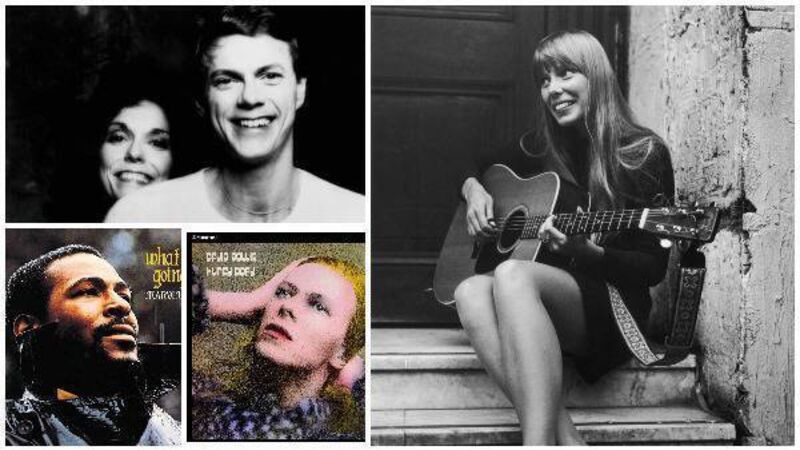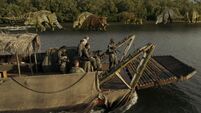Tom Dunne's Music & Me: How 1971 gave us Joni, Bowie, Marvin and so many more

The Carpenters, Marvin Gaye, David Bowie and Joni Mitchell were just some of the people who produced magnificent albums in 1971.
Occasionally an audio book can be so good it interrupts the dog walk. I’ll hear something and stop walking. But sometimes, some rare times, I have to actually sit down, crave the dog’s indulgence, and contemplate. David Hepworth and your fascinating book 1971 Never a Dull Moment, come on down.
Picture the scene: A&M’s recording studios in LA on corner of Sunset and La Brea. It’s a sunny mid-morning in January 1971. There are actually three studios, the main one, Studio A and two smaller, but no less impressive studios either side. All are in use.
The main studio is today housing The Carpenters who are recording their third album. But in the adjoining studio a young singer-songwriter from New York called Carole King is recording an album that will be called Tapestry. In the third an artist called Joni Mitchel is recording Blue.
Walking the corridor you could potentially have heard the nascent strains of Carey, You’ve Got a Friend and Rainy Days And Mondays as they entered the world! For further fun facts try these: Tapestry was recorded in just five, three-hour sessions. Carole’s preparation for the album sleeve photo shoot was to say, “Wait, I’ll get my jumper”.
I had skimmed Hepworth’s book on its release in 2016. But this year, as classic album after classic album celebrated its 50th anniversary I had to go back in. His argument that 1971 was a pivotal year in music is irrefutable. What a time it was to be alive, and better still, as Hepworth was, to be 21!
It was the year of not just Tapestry and Blue but also of Marvin Gaye’s What’s Going On, Bowie’s Hunky Dory, Led Zeppelin IV, Solo Beatles, Serge Gainsbourg’s Histoire de Melody Nelson, The Stones’ Sticky Fingers, Leonard Cohen’s Songs of Love and Hate, and others by Velvet Underground, Yes, Can, John Prine, The Who, T.Rex, Isaac Hayes and so many, many more.
Many of these albums are now some of the biggest sellers of all time. Others didn’t sell at the time but are now seen as classics of the genre- Nick Drake’s Bryter Layter. Others are simply regarded as the some of the greatest ever recorded – Gaye’s What’s Going On.
But what is even more fascinating is how so much of the world as we know it today was forming around this emerging scene. Prior to Tapestry young women had not been seen as ‘album buyers'. Cars were only starting to offer cassette players. Cassettes themselves were only starting to declare ‘Recorded in Stereo'.
A man in Chicago, a radio nerd but also the manager of a covers band, did something no one had ever thought of before: He started asking audiences what songs they would like to hear. When he had his list he wondered if he could apply the same format to radio. It became the format for FM radio that dominates the world to this day.
Meanwhile Led Zeppelin were eyeing America. Touring was more akin to simply playing a few dates at that point. Venues like Bill Graham’s Fillmore in San Francisco paid a set fee, arguing the venue was the brand. Zeppelin’s manager, John Grant, realised he was wrong. The bands were the brand. Graham was closing his venues within months.
As Joni, Carole and Karen were recording those albums in A&M Studios, we, here in Ireland, were preparing to host Eurovision in the Gaiety Theatre. Dana had won the year previously. Against the heady artistry of Tapestry and Blue, this might make us seem a little parochial but we were not alone.
In 1971 the UK still only had three TV stations and no commercial radio. It had Jimmy Savile promoting car safety belts, no one had a mobile or a computer, people smoked in hospitals and the Daily Mirror sold four and a half million copies a day. It seemed nothing, and no one, was cool.
Except perhaps one man. In January a man in an electric blue fur coat and velvet trousers was briefly detained at Washington’s Dulles Airport. It was this man’s first trip to America. But three weeks later, when he left, he was utterly transformed, besotted by all he had seen and heard.
One of his ideas was to create a musical character. The plan was for him to write the songs but for a man called Fred Burrett to do the legwork, touring and performing. Before this however he had time for one last album. Hunky Dory was released in December, 1971.


